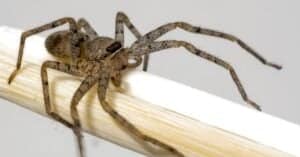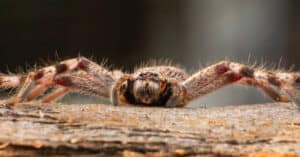The hackled orb weaver, native to the western United States, is a spider so small and delicate it can perch comfortably atop your finger. Yet, despite its tiny body, a great deal of complexity lies within its construction. Eight spindly legs move with the grace of a nimble dancer. Three claws help it maneuver around its gossamer home. Eight eyes perceive the world, though, in the dark, these spiders rely on touch to build their intricate nest.
It is this intricacy and the ability to construct it blindly that attracted researcher Andrew Gordus, senior author of a new study into the methodology of web weaving. He works in the Department of Biology at Krieger School of Arts and Sciences and became fascinated by the complex structures built by creatures with such small brains. “After seeing a spectacular web, I thought, ‘if you went to a zoo and saw a chimpanzee building this you’d think that’s one amazing and impressive chimpanzee,’” he said. But for a creature smaller than a fingertip, the feat was even more astounding.
So Gordus set about investigating the inner workings of spiders to determine how they manage their impressive constructions. With the help of technology, including artificial intelligence, his team successfully mapped the spider’s dance for the first time.
Artificial Intelligence Tracking Spiders’ Movement
The trouble in tracking a spider’s web building lies in both its complexity and its chosen hour. Hackled orb weavers build at night, creating an obstacle for Gordus and his team. To resolve that issue, they set up an infrared-lit space and cameras with the capability to record infrared light. The cameras recorded at a high frame rate in order to capture each individual leg’s motion, producing an immense amount of data.
That presents problem number two. “Even if you video record it, that’s a lot of legs to track, over a long time, across many individuals,” said Abel Corver, a graduate student and a lead author of the paper. The study included six spiders across multiple nights. That amounts to millions of frames that require annotation. A dataset nightmare for students becomes a treasure trove for an AI algorithm.
Rather than pore over the images, they designed a computer program to track each individual spider leg, as well as their relation to one another, to record the web weaver’s posture. The results were remarkable. The artificial intelligence was capable of predicting which phase of the construction process a spider was engaged with just by reading its leg positions.
By reviewing the data as metabolized by the artificial intelligence, researchers uncovered interesting findings. All the spiders in their study operated more or less in the same manner. The dance was the same across the species. This suggests the rules are coded into their brains. Reacting to the findings, Gordus said, “Now we want to know how those rules are encoded at the level of neurons.”
Spider Brains
The ability for tiny creatures like spiders to construct such complex webs illustrates something in biology known as Haller’s rule. It states that the smaller the creature, the greater proportion their brain has in comparison to their body. So, while spiders’ brains are much smaller, they retain greater capability than would be expected of their size. This evolutionary principle demonstrates the vitality of the brain.
It’s a process known as brain miniaturization. Like technological advancements that permit more complex computational power to fit within smaller and smaller devices, little brains compact as they evolve. William Eberhard, a spider researcher at the Tropical Research Institute, explained to Scientific American how spider brains got creative with space in smaller arachnids. “In the tiny ones they were going into the legs, and the sternum was bulging out, and it was full of brain,” he said.
To research this phenomenon, Eberhard studied web making spiders of different sizes. He wanted to see whether larger spiders made fewer mistakes on account of having larger brains. The results surprised him. No matter the size of the spider, nor even the space in which they made their web, the number of mistakes remained constant.
Haller’s rule applies across all species, ensuring brain complexity remains despite environmental pressures shrinking the overall size of an animal. It functions in a variety of ways, from thinning the skull to shrinking the size of brain cells and their connecting axons. Or, in the case of spiders, fitting brain matter elsewhere in the body.
Following their recent study, Gordus and his team hope to further their research by peeking into the brains of spiders as they set about their task. With the use of various drugs, they wish to observe the circuitry of the brain to determine which switches correspond to each part of the web building process. By digging into the functionality of these small, yet complex brains, researchers may unravel some of the mystery of our own minds, as well as contribute interesting solutions for computer scientists that look increasingly to nature for inspiration.
The photo featured at the top of this post is ©
Sources
- John Hopkins University, Available here: https://hub.jhu.edu/2021/11/02/spiders-web-secrets-unraveled/
- Scientific American, Available here: https://www.scientificamerican.com/article/the-genius-of-pinheads-when-little-brains-rule/
- Popular Mechanics, Available here: https://www.popularmechanics.com/science/animals/g518/8-amazing-architects-of-the-animal-kingdom/?slide=8
FAQs (Frequently Asked Questions)
What other animals create complex structures like spiderwebs?
A vast array of beautiful and fascinating structures appear in nature. One of the most efficient is the honeycomb built by honey bees. Thomas Hales, a mathematician, even demonstrated how the use of a hexagonal tessellation uses the least amount of perimeter, and thus materials, to divide a given plane. In other words, honey bees make exceptionally good use of their space.
Another amazing structure found in nature are prairie dog towns. Their burrows reach varying depths to provide for different purposes. For example, they keep their young in the deepest rooms, which provide the most stable temperatures as well as the greatest protection against predators. Though prairie dog towns now house up to 35 rodents, prior to human incursion, they stretched vast territory. One discovered in Texas in 1900 housed an estimated 400 million, covering an area of 25,000 square miles.
Check out these 9 animal architects to learn more about smart designs in the animal kingdom.
Thank you for reading! Have some feedback for us? Contact the AZ Animals editorial team.






